|
"Hats off to Vietnam"
Trekking through mountain villages near Sapa, North Vietnam
by Sarah Shuckburgh
Sarah Shuckburgh is humbled by
the people's warmth and beauty while on a walking trip
through mountain villages.
We spent our first night in Vietnam in one of Asia’s
smartest colonial hotels. After basking in fragrant bubbles
in our marble bathroom, we reclined on soft pillows in our
kingsize bed, and nibbled pale-skinned mangoes, succulent
star-apples and fire-dragon fruit. Three days later, we
found ourselves sleeping on a bamboo mat, with a rock-hard
pillow, eating food cooked on an open fire, and washing at a
cold water tap shared with pigs and chickens. But my husband
Guillaume and I agreed that our nights in village houses
were the highlight of our trip.
We arrived in the Tonkinese highlands in dense fog and rain.
Eerie nothingness enveloped the narrow winding road, as our
van bumped over potholes, skidded over deep ruts in the red
mud, edged round landslides, and splashed through deep
puddles. We passed wobbly motorcyclists, their plastic
sandals skimming the mud. Once, round a corner, a boy on a
bicycle careered out of control and hit us with a sickening
thud. Our driver leapt out, and when he discovered that the
lad wasn’t dead, smacked him about the face, yanked his ear,
and threw the bike in the ditch.
 The drizzle continued as we drove up and up. The prospect of
three days’ walking and exploring was daunting - what was
the point of discomfort in pea-soup fog? As we checked into
our hotel in Sapa, a crash of thunder heralded a heavy
downpour. And my apprehension increased with our trekking
guide’s first comment: “You are even older than my mother.” The drizzle continued as we drove up and up. The prospect of
three days’ walking and exploring was daunting - what was
the point of discomfort in pea-soup fog? As we checked into
our hotel in Sapa, a crash of thunder heralded a heavy
downpour. And my apprehension increased with our trekking
guide’s first comment: “You are even older than my mother.”
It rained all night, but the next morning we woke to watery
sunshine. The air was damp and cool, but the mist had
lifted, and a spectacular panorama of mountains had
appeared. We climbed into a dilapidated Russian jeep with
our guide, three porters and wicker baskets piled with food,
and lurched off up a precipitous mountain road, to the start
of our trek.
As soon as we started walking, our spirits soared.
Astounding views opened up in every direction. On steep
mountainsides, narrow paddy fields gleamed in swirling
stripes of green and grey, some dry and some flooded. Above
the endless curving lines of the terraces, thick, dark
forest covered every peak. Far below, a red muddy river
snaked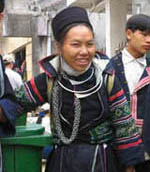 between clusters of grey-roofed bamboo houses. between clusters of grey-roofed bamboo houses.
It
was the week of the Tet festival, a time when everyone stops
work to celebrate the start of spring. All along the gravel
track, youngsters from the Black H’Mong ethnic group were
parading in their best clothes - the girls in dangling
silver earrings, and black embroidered skirts and bodices,
with puttees wound below their bare knees; the boys in black
baggy trousers, skull caps, tight high-necked jackets, and
long sleeveless jerkins with side vents and embroidered
sailor collars, with heavy silver necklaces.
“Tet is the mating season,” explained our guide, Son. "Boys
and girls are flirting. And soon it will be the wedding
season.”
 Suddenly we heard thunder. Seconds later the sky darkened,
and huge raindrops plopped on to our heads. Son led us to a
thatched shack of mud and bamboo, home to a H’Mong family of
fifteen. Picking our way past chickens and pigs, we stepped
over a lintel on to a rough mud floor, where three tiny
women in black embroidered costumes crouched in the gloom,
husking cobs of corn. They greeted us with smiles, and
carried on working with gnarled fingers, their silver
bracelets tinkling. Smoke curled up from a small fire of
twigs on the floor, past an assortment of cured animals
dangling from the rafters. Under the thatch at the door,
three toothless men sheltered from the storm, their black
trousers rolled up, and their calves stained blue with
indigo dye. Suddenly we heard thunder. Seconds later the sky darkened,
and huge raindrops plopped on to our heads. Son led us to a
thatched shack of mud and bamboo, home to a H’Mong family of
fifteen. Picking our way past chickens and pigs, we stepped
over a lintel on to a rough mud floor, where three tiny
women in black embroidered costumes crouched in the gloom,
husking cobs of corn. They greeted us with smiles, and
carried on working with gnarled fingers, their silver
bracelets tinkling. Smoke curled up from a small fire of
twigs on the floor, past an assortment of cured animals
dangling from the rafters. Under the thatch at the door,
three toothless men sheltered from the storm, their black
trousers rolled up, and their calves stained blue with
indigo dye.
When the rain stopped, we exchanged more nods and smiles,
and stepped out into the sparkling mountain air. We walked
on, mesmerised by the glittering paddy fields which curved
in dizzy, asymmetrical patterns round every hillside,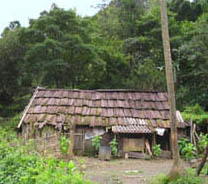 catching the light in a thousand different shades of green
and grey. Leaving the land of the Black H’Mong, we reached a
village of the Tai ethnic minority, and stopped for lunch at
a bamboo house on stilts. A black pot-bellied pig snoozed in
the sunshine with its piglets, and chickens pecked among the
cabbages. A skinny dog (another source of meat) was tethered
to a bamboo pole. A barefooted Tai woman, wearing trousers
of shiny black satin, and a
catching the light in a thousand different shades of green
and grey. Leaving the land of the Black H’Mong, we reached a
village of the Tai ethnic minority, and stopped for lunch at
a bamboo house on stilts. A black pot-bellied pig snoozed in
the sunshine with its piglets, and chickens pecked among the
cabbages. A skinny dog (another source of meat) was tethered
to a bamboo pole. A barefooted Tai woman, wearing trousers
of shiny black satin, and a
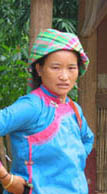 leaf-green woven headscarf,
beckoned us into a barn-like room where our porters were
already squatting by the fire, cooking noodle soup. With
difficulty Guillaume and I perched on tiny wooden stools, no
more than four inches high, and sipped green tea from tiny
bowls, poured from a vast rusty thermos. Seventeen people
lived in this house, and the family’s few possessions were
poked into the woven walls – a small besom, some scythes, a
basket of chopsticks, a comb and a tiny mirror. leaf-green woven headscarf,
beckoned us into a barn-like room where our porters were
already squatting by the fire, cooking noodle soup. With
difficulty Guillaume and I perched on tiny wooden stools, no
more than four inches high, and sipped green tea from tiny
bowls, poured from a vast rusty thermos. Seventeen people
lived in this house, and the family’s few possessions were
poked into the woven walls – a small besom, some scythes, a
basket of chopsticks, a comb and a tiny mirror.
While we ate lunch, the old grandfather squatted beside us,
his trousers rolled up, his feet bare, and deftly wove a
fish trap from strips of bamboo. Elsewhere in Vietnam,
farmers harvest two or even three rice crops every year, but
in the highlands they only plant one crop, in June. In
winter, the men hunt animals in the forest, and fish in the
river.
Tet is a fascinating time to visit the mountains. Red and
yellow Vietnamese flags fluttered above every house, and
through doorways we glimpsed shrines to ancestors, heaped
with offerings, joss sticks and peach blossom. Everybody
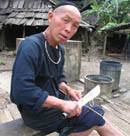 gets one year older at Tet – like thoroughbred horses in the
west. Many superstitions surround Tet: ancestors’ tombs must
be tended, special food must be eaten, and it is an
auspicious time for home improvements. In one village, we watched a family prepare for the forthcoming wedding season
by building an extension for their married sons. Everyone
was helping – men were hacking stones and loading them on to
a buffalo cart; women were digging up a paddy field to make
the building plot; boys were chiselling, hammering, and
cutting bamboo with a two-man handsaw; and an old man was
whittling wooden pegs. In these mountains, most marry at 14
or 15, and brides live with their in-laws. Rural families
long for sons, who will care for them in their old age, and
dread the birth of girls. gets one year older at Tet – like thoroughbred horses in the
west. Many superstitions surround Tet: ancestors’ tombs must
be tended, special food must be eaten, and it is an
auspicious time for home improvements. In one village, we watched a family prepare for the forthcoming wedding season
by building an extension for their married sons. Everyone
was helping – men were hacking stones and loading them on to
a buffalo cart; women were digging up a paddy field to make
the building plot; boys were chiselling, hammering, and
cutting bamboo with a two-man handsaw; and an old man was
whittling wooden pegs. In these mountains, most marry at 14
or 15, and brides live with their in-laws. Rural families
long for sons, who will care for them in their old age, and
dread the birth of girls.
At dusk, we arrived at another Tai village. Open drains,
made from bamboo, flowed through narrow alleys between
stilted houses. Old women worked spinning wheels in
doorways. A small shop displayed plastic sandals, sleeping
mats, tin bowls and lengths of hosepipe. Our host family
consisted of four generations – 19 people, headed by a
45-year-old patriarch. On the first floor, the ancestral
shrine was decorated with peach blossom, bananas,
sticky-rice cakes, cellophane-wrapped sweets and some limp
balloons. A shiny three-piece suite held pride of place, but
the family spent the evening downstairs, sitting on tiny
stools round the smouldering logs, an occasional gold tooth
glinting in the gloom. Everything in the house was
earth-coloured – the mud floor, the big pot of simmering
pig-food, the vat for brewing rice wine, the sacks of rice,
the walls of woven
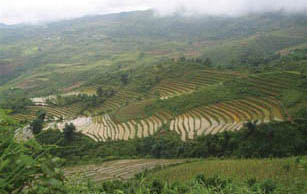 bamboo, unadorned except for sheets of
yellowing newspaper and some tattered school certificates,
stuck over the largest gaps. The remains of a pig, killed
for Tet, hung over the smoking fire. bamboo, unadorned except for sheets of
yellowing newspaper and some tattered school certificates,
stuck over the largest gaps. The remains of a pig, killed
for Tet, hung over the smoking fire.
That night we slept fitfully on a bamboo mat on a
second-floor balcony, our heads rigid on brick-sized blocks.
Once I ventured with my torch down the two ladders, past our
sleeping porters who sprawled, fully dressed, by the embers
of the fire, and across the pitch-black yard to the loo, a
primitive arrangement which flowed straight out to the pigs.
Back on our mat, I lay awake listening to snores from other
sleepers, creaks of the bamboo floor, rain falling on the
thatch, pigs grunting, and finally cockerels greeting the
dawn.
The next morning, we gave the youngest children colourful
envelopes containing crisp new money – which we had learned
was a traditional Tet custom – and set off again on our
trek. Our route contoured round the steep hillside –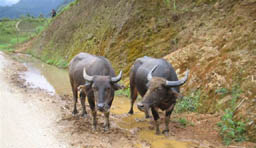 much of
it deforested - on tracks of sand and gravel, or mud, or
roughly paved with stones. Only two motorbikes passed all
morning. Sometimes we wobbled along narrow dykes between
waterlogged paddy fields, where blue mint-like flowers grew
wild, and families of buffalo wallowed. As we approached a
Green H’Mong village, more flirting youngsters appeared,
these girls wearing turquoise aprons and sashes, with their
hair scraped into square green headdresses. Some had
circular brown scars on their foreheads – burns caused by
the local headache treatment of buffalo horn and herbs. A
group of older montagnards staggered about, drunk on rice
wine. much of
it deforested - on tracks of sand and gravel, or mud, or
roughly paved with stones. Only two motorbikes passed all
morning. Sometimes we wobbled along narrow dykes between
waterlogged paddy fields, where blue mint-like flowers grew
wild, and families of buffalo wallowed. As we approached a
Green H’Mong village, more flirting youngsters appeared,
these girls wearing turquoise aprons and sashes, with their
hair scraped into square green headdresses. Some had
circular brown scars on their foreheads – burns caused by
the local headache treatment of buffalo horn and herbs. A
group of older montagnards staggered about, drunk on rice
wine.
In the next valley, we reached the scattered hamlets of the
Red Dao ethnic group, whose womenfolk were startling to look
at, with eyebrows and crowns plucked like Elizabethan
ladies, and extraordinary turbans trimmed with dozens of red
tassels, silver coins and tiny bells. Their black trousers
and tunics were embroidered with tiny white stitches, and
more scarlet pompoms cascaded from sashes and aprons. Broad
smiles revealed black lacquered teeth, or mouths full of red
betel juice.
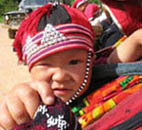 That night we stayed with another huge extended family,
headed by a grandfather aged 38. Chickens, ducks and pigs
wandered among fruit trees, as water gushed through small
bamboo water mills. The babies were charmingly kitted out in
miniature versions of their mothers’ headdresses, with tiny
red pompoms, lucky coins and tinkling bells. At the door,
beneath tattered banners of Chinese calligraphy, four
generations of daughters-in-law sat, resplendent in red
tassels and silver bangles, embroidering tiny white
cross-stitches on to black cotton, and occasionally hurling
stones at a mangy dog. A group of men sat nearby, sharing a
bamboo pipe – an elaborate ritual of inhaling smoke through
water. That night we stayed with another huge extended family,
headed by a grandfather aged 38. Chickens, ducks and pigs
wandered among fruit trees, as water gushed through small
bamboo water mills. The babies were charmingly kitted out in
miniature versions of their mothers’ headdresses, with tiny
red pompoms, lucky coins and tinkling bells. At the door,
beneath tattered banners of Chinese calligraphy, four
generations of daughters-in-law sat, resplendent in red
tassels and silver bangles, embroidering tiny white
cross-stitches on to black cotton, and occasionally hurling
stones at a mangy dog. A group of men sat nearby, sharing a
bamboo pipe – an elaborate ritual of inhaling smoke through
water.
Inside the cave-like kitchen, huge blackened pots perched on
metal poles over the fire on the earth floor. Pig food
simmered in one; another contained our supper. Around the
room were wooden sleeping platforms, piles of grain, sacks
of rice, bundles of sticks and rushes - and a motorbike.
That night on our bamboo mat, we made soft pillows out of
our jerseys, and were lulled to sleep by the clanking and
whooshing of the water mills.
By the third day of our trek, our clothes were creased and
spattered with red mud, but the courting youngsters still
looked impeccably clean, from their plastic sandals to their
elaborate headdresses. Guillaume and I were just pondering
whether western trekkers in tee shirts, walking boots and
fleeces would threaten local ethnic traditions, when our
guide roars with laughter:
“Three very, very fat trekkers are on the path ahead – even
fatter than you.”
Minutes later, three Canadians of perfectly normal
proportions appeared, and we suddenly saw ourselves as the
small, lithe, beautifully dressed highlanders might – our
faces pallid and blubbery, our heads bare and tousled,
wearing colourless, ill-fitting, unembroidered clothes.
As the battered army jeep took us back to Sapa, the shadows
lengthened, the colours of the rice fields intensified, and
the landscape of soft, swirling lines looked achingly
beautiful. All along the road, flirting couples were walking
together, in their embroidered finery.
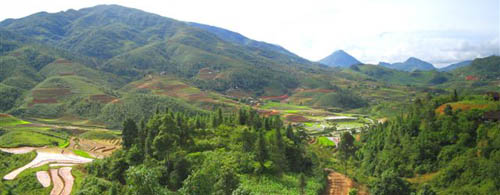
First published by the Telegraph
©SarahShuckburgh |